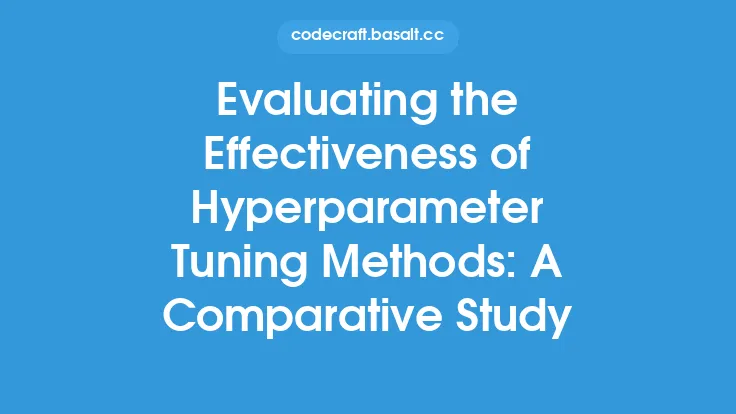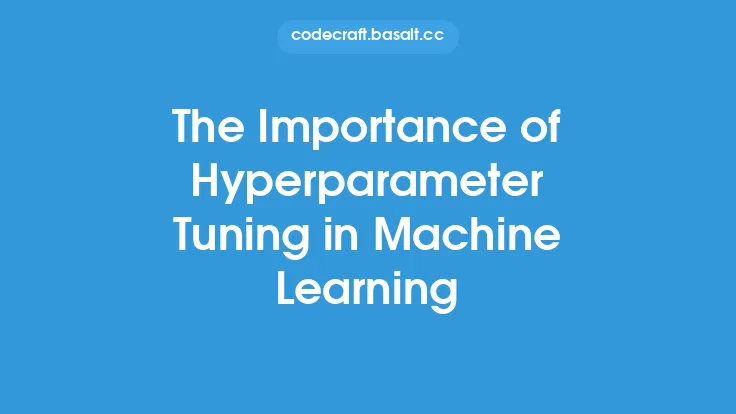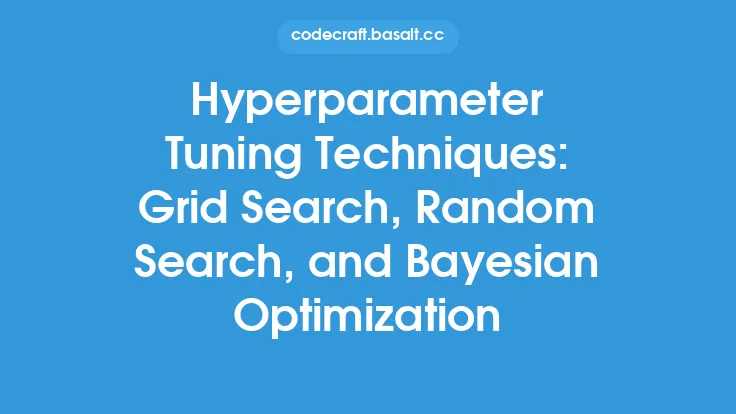Hyperparameter tuning is a crucial step in the machine learning workflow, as it enables data scientists and engineers to optimize the performance of their models. In essence, hyperparameters are parameters that are set before training a model, and they can have a significant impact on the model's ability to generalize to new, unseen data. In this article, we will delve into the world of hyperparameter tuning, exploring the fundamentals, benefits, and techniques involved in optimizing machine learning models.
Introduction to Hyperparameters
Hyperparameters are parameters that are not learned during the training process, but are instead set prior to training. They can include parameters such as the learning rate, regularization strength, and number of hidden layers in a neural network. Hyperparameters can be thought of as " knobs" that control the behavior of a machine learning model, and finding the optimal combination of hyperparameters is essential for achieving good performance. Hyperparameters can be categorized into two main types: model hyperparameters and algorithm hyperparameters. Model hyperparameters are specific to a particular model, such as the number of hidden layers in a neural network, while algorithm hyperparameters are more general, such as the learning rate or batch size.
Why is Hyperparameter Tuning Important?
Hyperparameter tuning is important because it allows data scientists and engineers to optimize the performance of their models. A well-tuned model can result in improved accuracy, precision, and recall, as well as reduced overfitting and underfitting. Hyperparameter tuning can also help to reduce the risk of model bias and variance, which can occur when a model is overly complex or overly simple. Furthermore, hyperparameter tuning can help to improve the interpretability of a model, by identifying the most important features and relationships in the data. In addition, hyperparameter tuning can be used to compare the performance of different models, and to identify the best model for a particular problem.
Types of Hyperparameters
There are several types of hyperparameters that can be tuned, including:
- Learning rate: The learning rate determines how quickly a model learns from the training data. A high learning rate can result in fast convergence, but may also cause the model to overshoot the optimal solution.
- Regularization strength: Regularization strength determines the amount of penalty applied to the model for large weights. A high regularization strength can help to prevent overfitting, but may also result in underfitting.
- Number of hidden layers: The number of hidden layers in a neural network determines the complexity of the model. Increasing the number of hidden layers can result in improved performance, but may also increase the risk of overfitting.
- Batch size: The batch size determines the number of samples that are used to compute the gradient of the loss function. A large batch size can result in faster convergence, but may also increase the risk of overfitting.
- Activation functions: Activation functions determine the output of a neuron in a neural network. Common activation functions include sigmoid, tanh, and ReLU.
Hyperparameter Tuning Techniques
There are several hyperparameter tuning techniques that can be used, including:
- Grid search: Grid search involves searching through a predefined grid of hyperparameters to find the optimal combination.
- Random search: Random search involves randomly sampling the hyperparameter space to find the optimal combination.
- Bayesian optimization: Bayesian optimization involves using a probabilistic approach to search for the optimal combination of hyperparameters.
- Gradient-based optimization: Gradient-based optimization involves using gradient descent to search for the optimal combination of hyperparameters.
- Evolutionary algorithms: Evolutionary algorithms involve using evolutionary principles, such as natural selection and mutation, to search for the optimal combination of hyperparameters.
Hyperparameter Tuning Tools and Libraries
There are several hyperparameter tuning tools and libraries available, including:
- Hyperopt: Hyperopt is a Python library that provides a simple and efficient way to perform hyperparameter tuning.
- Optuna: Optuna is a Python library that provides a Bayesian optimization approach to hyperparameter tuning.
- Scikit-learn: Scikit-learn is a Python library that provides a range of tools and techniques for hyperparameter tuning, including grid search and random search.
- TensorFlow: TensorFlow is a Python library that provides a range of tools and techniques for hyperparameter tuning, including gradient-based optimization and Bayesian optimization.
- PyTorch: PyTorch is a Python library that provides a range of tools and techniques for hyperparameter tuning, including gradient-based optimization and Bayesian optimization.
Best Practices for Hyperparameter Tuning
There are several best practices that can be followed when performing hyperparameter tuning, including:
- Start with a small grid: Starting with a small grid of hyperparameters can help to reduce the computational cost of hyperparameter tuning.
- Use a validation set: Using a validation set can help to evaluate the performance of a model and prevent overfitting.
- Monitor performance metrics: Monitoring performance metrics, such as accuracy and loss, can help to identify the optimal combination of hyperparameters.
- Use a random search: Using a random search can help to avoid getting stuck in a local optimum.
- Use a Bayesian optimization approach: Using a Bayesian optimization approach can help to efficiently search the hyperparameter space.
Common Challenges and Pitfalls
There are several common challenges and pitfalls that can occur when performing hyperparameter tuning, including:
- Overfitting: Overfitting can occur when a model is too complex and fits the training data too closely.
- Underfitting: Underfitting can occur when a model is too simple and fails to capture the underlying patterns in the data.
- Computational cost: Hyperparameter tuning can be computationally expensive, especially when using a large grid of hyperparameters.
- Local optima: Local optima can occur when a model gets stuck in a local optimum and fails to converge to the global optimum.
- Hyperparameter interactions: Hyperparameter interactions can occur when the optimal value of one hyperparameter depends on the value of another hyperparameter.





